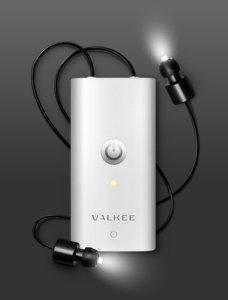 Finnish company Valkee has promoted a device that looks like an mp3 player but where the earbuds have bright LED lights that are there to allegedly stimulate the brain via the ear canal. The company suggests that the light simulates the mood-elevating effects of the sun, by channeling safe bright light directly to photosensitive regions of the brain through the ear canal.
Finnish company Valkee has promoted a device that looks like an mp3 player but where the earbuds have bright LED lights that are there to allegedly stimulate the brain via the ear canal. The company suggests that the light simulates the mood-elevating effects of the sun, by channeling safe bright light directly to photosensitive regions of the brain through the ear canal.
The company suggests that the device can be used to treat seasonal affective disorder (SAD), or what is often referred to as the winter blues, the feeling of lethargy and depressiveness experienced by people during the winter months when there is less sunlight exposure. A small trial from Oulu University suggests that the claims made by the company before the research was done might warrant further investigation.
However, there is scant evidence that the brain responds to light in the way the company suggests, the trial involved just 13 people, there was no control. Moreover, the light from the LEDs is very weak, can it really penetrate to the surface of the brain?
The company says, “Valkee increases energy, and can act as a preventative or treatment of mood swings.” I’m never sure what alternative medicine practitioners actually mean by “energy”, they’re either talking about some spurious mystical nonsense like Qi (pronounced “chee”) or they just mean feelings of well-being. Either way, if it cannot be measured in Joules it’s not energy.
For some reason, The Guardian Technology Podcast picked up on the existence of Valkee a short time ago (presumably because their correspondent Charles Arthur just happened to be visiting Finland and needed a local company to talk about). He did ask about placebos and controls and I am sure I heard the company representative say that they couldn’t do placebo controlled tests without lying to the subjects. My curiosity was piqued at the time but having received a test gadget I really am even less convinced, especially as it seems SAD is not really a winter-time “depression” at all, but can occur any time of the year and moreover depression, and general misery seem not to be seasonal despite the claims of those hoping to medicalize melancholy.
Valkee’s chief executive Timo Ahopelto told me that depression is a disease that takes a long time to develop and a long time to cure. “Many antidepressants take 3-6 months to have an effect,” he says. “Although with some SAD sufferers we see an immediate effect after 1-3 days of usage, most typically the symptoms resolve after 1-2 weeks.” He adds that, “As the light has an immediate effect, it can cure mood states like jetlag and act as a preventative to migraine. For disorders that by their nature have longer mechanisms, it takes longer.”
I am still not convinced that SAD is really anything more than what the Victorians referred to as suffering from malaise or melancholy. Indeed, some light therapy companies claim benefits can be achieved after just one session whereas the little bits of research that have been done suggest it takes weeks of daily use of the light source. To my mind, the best answer if you’ve got the winter blues and are able is to grab your hat and coat and get yourself outside into the fresh air and take a nice long walk. Get the available sunlight on your face.
![]() Timonen M, Nissilä J, Liettu A, Jokelainen J, Jurvelin H, Aunio A, Räsänen P, & Takala T (2012). Can transcranial brain-targeted bright light treatment via ear canals be effective in relieving symptoms in seasonal affective disorder? – A pilot study. Medical hypotheses PMID: 22296809
Timonen M, Nissilä J, Liettu A, Jokelainen J, Jurvelin H, Aunio A, Räsänen P, & Takala T (2012). Can transcranial brain-targeted bright light treatment via ear canals be effective in relieving symptoms in seasonal affective disorder? – A pilot study. Medical hypotheses PMID: 22296809
The Valkee device costs an astounding GBP185 but seems to be nothing more than two LEDs that produce the equivalent of a half-watt incandescent lightbulb each, a couple of bits of stiff and noisy (when the buds are in your ears) wire, and a little box with a USB slot, an on-off button and presumably a timer circuit to illuminate the LEDs. I reckon I could make one for about 20 quid with bits from Tandy/Radio Shack. The medical certification mentioned on the company’s website is all well and good but says nothing of therapeutic efficacy.
More in my February Pivot Points column in The Euroscientist.